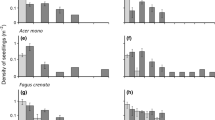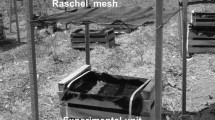Abstract
Competition is believed to be a central force limiting local diversity and controlling the structure of plant communities. However, it has been proposed that the stressed understory environment limits total understory plant density to such low levels that competitive exclusion cannot be an important factor limiting the local diversity of understory plants. To evaluate the importance of inter-seedling competition, we performed a seedling competition experiment with five shade-tolerant species in a tropical moist forest in Panama. Three-month-old seedlings were transplanted into the forest singly or with their roots intertwined with a single conspecific or heterospecific seedling in all pairwise species combinations. If competition is important, performance (survival, stem height, and number of leaves after one and six years) would be expected to be lowest with a conspecific neighbor and greatest without a neighbor. The experiment was replicated in five 0.24-m2 plots at each of 20 sites in tall secondary forest. To test whether seedling performance differed among treatments we fitted linear mixed models (LMM) and generalized linear mixed models (GLMM), treating species identity and microsite (site and plot) as random effects. The five shade-tolerant study species all experienced good establishment with relatively high survival and growth rates. The neighbor treatment consistently affected seedling performance, but the effect was always very small, both in absolute terms and relative to the much stronger species and microsite effects. Seedlings with a conspecific neighbor consistently performed worse than seedlings with a heterospecific neighbor, but having no neighbor generally did not cause superior performance relative to the other treatments. We conclude that direct competitive interactions are relatively unimportant among understory plants in humid tropical forests.


Similar content being viewed by others
References
Ashton PS (1993) Species richness in plant communities. In: Fiedler PL, Jain SK (eds) Conservation biology. Chapman and Hall, New York, pp 4–22
Augspurger CK, Kelly CK (1984) Pathogen mortality of tropical tree seedlings: experimental studies of the effects of dispersal distance, seedling density, and light conditions. Oecologia 61:211–217
Barberis IM, Tanner EVJ (2005) Gaps and root trenching increase tree seedling growth in Panamanian semi-evergreen forest. Ecology 86:667–674
Bates D, Sarkar D (2007) lme4: Linear mixed-effects models using S4 classes. R package version 0.9975-13. http://cran.r-project.org/src/contrib/Descriptions/lme4.html. Cited 11 October 2007
Benitez-Malvido J (2006) Effect of low vegetation on the recruitment of plants in successional habitat types. Biotropica 38:171–182
Brown ND, Whitmore TC (1992) Do dipterocarp seedlings really partition tropical rain forest gaps? Phil Trans R Soc Lond Ser B 354:369–378
Callaway RM, Walker LR (1997) Competition and facilitation: a synthetic approach to interactions in plant communities. Ecology 78:1958–1965
Cintra R, Horna V (1997) Seed and seedling survival of the palm Astrocayum murumuru and the legume tree Dipteryx micrantha in gaps in Amazonian forest. J Trop Ecol 13:257–277
Collins BS, Dunne KP, Pickett STA (1985) Responses of forest herbs to canopy gaps. In: Pickett STA, White PS (eds) The ecology of natural disturbance and patch dynamics. Academic, Orlando, FL, pp 217–234
Coomes DA, Grubb PJ (2000) Impacts of root competition in forests and woodlands: a theoretical framework and review of experiments. Ecol Monogr 70:171–207
Crawley MJ (1997) The structure of plant communities. In: Crawley MJ (ed) Plant ecology. Blackwell, Oxford, pp 475–531
Croat TB (1978) Flora of Barro Colorado Island. Stanford University Press, Stanford, CA
Dalling JW, Muller-Landau HC, Wright SJ, Hubbell SP (2002) Role of dispersal in the recruitment limitation of neotropical pioneer species. J Ecol 90:714–727
Ehrlén J, Eriksson O (2000) Dispersal limitation and patch occupancy in forest herbs. Ecology 81:1667–1674
Fabbro T (2007) asuR: advanced statistics using R. R package version 0.08-22. http://cran.r-project.org/src/contrib/Descriptions/asuR.html. Cited 11 October 2007
Foster RB, Brokaw NVL (1996) Structure and history of the vegetation of Barro Colorado Island. In: Leigh EG, Rand AS, Windsor DM (eds) The ecology of a tropical forest: seasonal rhythms and long-term changes. Smithsonian Institution, Washington, DC, pp 67–82
Gentry AH (ed) (1990) Four neotropical rainforests. Yale University Press, New Haven, CT
Gentry AH, Dodson C (1987) Contribution of nontrees to species richness of a tropical rain forest. Biotropica 19:149–156
Gilbert GS, Harms KE, Hamill DN, Hubbell SP (2001) Effects of seedling size, El Niño drought, seedling density, and distance to nearest conspecific adult on 6-year survival of Ocotea whitei seedlings in Panamá. Oecologia 127:509–516
Grime JP (1979) Plant strategies and vegetation processes. Wiley, Chichester, UK
Goldberg DE, Barton AM (1992) Patterns and consequences of interspecific competition in natural communities: a review of field experiments with plants. Am Nat 139:771–801
Goldberg DE, Scheiner SM (1993) ANOVA and ANCOVA: field competition experiments. In: Scheiner SM, Gurevitch J (eds) Design and analysis of ecological experiments. Chapman & Hall, New York
Harms KE, Wright SJ, Calderón O, Hernández A, Herre EA (2000) Pervasive density-dependent recruitment enhances seedling diversity in a tropical forest. Nature 404:493–495
Harms KE, Powers JS, Montgomery RA (2004) Variation in small sapling density, understory cover, and resource availability in four neotropical forests. Biotropica 36:40–51
Hubbell SP (2001) The unified neutral theory of biodiversity and biogeography. Princeton University Press, Princeton, NJ
Hubbell SP, Foster RB, O’Brien ST, Harms KE, Condit R, Wechsler B, Wright SJ, Loo de Lao S (1999) Light-gap disturbances, recruitment limitation, and tree diversity in a Neotropical forest. Science 283:554–557
Kitajima K (1994) Relative importance of photosynthetic traits and allocation patterns as correlates of seedling shade tolerance of 13 tropical trees. Oecologia 98:419–428
Kobe RK (1999) Light gradient partitioning among tropical tree species through differential seedling mortality and growth. Ecology 80:187–201
Leigh EG (1999) Tropical forest ecology: a view from Barro Colorado Island. Oxford University Press, New York
Leigh EG, Rand AS, Windsor DM (eds) (1996) The ecology of a tropical forest: seasonal rhythms and long-term changes. Smithsonian Institution Press, Washington, DC
MacDougal A, Kellman M (1992) The understory light regime and patterns of tree seedlings in tropical riparian forest patches. J Biogeogr 19:667–675
Makana JR, Thomas C (2004) Dispersal limits natural recruitment of African mahoganies. OIKOS 106:67–72
Marquis RJ, Young HJ, Braker HE (1986) The influence of understory vegetation cover on germination and seedling establishment in a tropical lowland wet forest. Biotropica 18:273–278
McCulloch CE, Searle SR (2001) Generalized, linear, and mixed models. Wiley, New York
Montgomery RA, Chazdon RL (2002) Light gradient partitioning by tropical tree seedlings in the absence of canopy gaps. Oecologia 131:165–174
Muller-Landau HC, Wright SJ, Calderón O, Hubbell SP, Foster RB (2002) Assessing recruitment limitation: concepts, methods and case-studies from a tropical forest. In: Levey DJ, Silva WR, Galetti M (eds) Seed dispersal and frugivory: ecology, evolution, and conservation. CABI Publishing, Wallingford, UK, pp 35–53
Muller-Landau HC, Dalling JW, Harms KE, Wright SJ, Condit R, Hubbell SP, Foster RB (2004) Seed dispersal and density-dependent seed and seeding mortality in Trichilia tuberculata and Miconia argentea. In: Losos EC, Leigh EG (eds) Tropical forest diversity and dynamism: findings from a large-scale plot network. University of Chicago Press, Chicago, IL, pp 340–362
Packer A, Clay K (2000) Soil pathogens and spatial patterns of seedling mortality in a temperate tree. Nature 404:278–281
Paz H, Martínez-Ramos M (2002) Seed mass and seedling performance within eight species of Psychotria (Rubiaceae). Ecology 84:439–450
Pinheiro J, Bates DM (2001) Mixed effects models in S and S-PLUS. Springer, New York
R Development Core Team (2007) R: a language and environment for statistical computing. R Foundation for Statistical Computing, Vienna, Austria (see http://www.R-project.org)
Reynolds HL (1999) Plant interactions: competition. In: Pugnaire FI, Valladares F (eds) Handbook of functional plant ecology. Marcel Dekker, New York, pp 649–676
Svenning JC (1999) Microhabitat specialization in a species-rich palm community in Amazonian Ecuador. J Ecol 87:55–65
Svenning JC (2000) Small canopy gaps influence plant distributions in the rain forest understory. Biotropica 32:252–261
Svenning JC (2001) On the role of microenvironmental heterogeneity in the ecology and diversification of neotropical rain-forest palms (Arecaceae). Bot Rev 67:1–53
Svenning JC (2002) Crown illumination limits the population growth rate of a neotropical understorey palm (Geonoma macrostachys, Arecaceae). Plant Ecol 159:185–199
Svenning J-C, Wright SJ (2005) Seed limitation in a Panamanian forest. J Ecol 93:853–862
Thomsen RP, Svenning J-C, Balslev H (2005) Overstorey control of understorey species composition in a near-natural temperate broadleaved forest in Denmark. Plant Ecol 181:113–126
Tilman D (1982) Resource competition and community structure (Monographs in population biology). Princeton University Press, Princeton, NJ
Tilman D, Pacala S (1993) The maintenance of species richness in plant communities. In: Ricklefs RE, Schluter D (eds) Species diversity in ecological communities. University of Chicago Press, Chicago, IL, pp 13–25
Turnbull LA, Crawley MJ, Rees M (2000) Are plant populations seed-limited? A review of seed sowing experiments. Oikos 88:225–238
Wright SJ (1992) Seasonal drought, soil fertility and the species density of tropical forest plant communities. Trends Ecol Evol 7:260–263
Wright SJ (2002) Plant diversity in tropical forests: a review of mechanisms of species coexistence. Oecologia 130:1–14
Wright SJ, Muller-Landau HC, Calderón O, Hernandéz A (2005) Annual and spatial variation in seedfall and seedling recruitment in a Neotropical forest. Ecology 86:848–886
Acknowledgments
We thank Sebastian Bernal for assistance with field work and Christopher Baraloto for insightful and constructive criticism that have greatly improved the manuscript. The Carlsberg Foundation (grants 990086/20 and 990576/20 to JCS), The Danish Natural Science Research Council (grants 9901835, 51-00-0138, 21-01-0415, and 21-04-0346 to JCS) and the Andrew W. Mellon Foundation (to SJW) provided financial support. The reported experiment complied with Panamanian laws.
Author information
Authors and Affiliations
Corresponding author
Additional information
Communicated by Stephan Hättenschwiler.
Rights and permissions
About this article
Cite this article
Svenning, J.C., Fabbro, T. & Wright, S.J. Seedling interactions in a tropical forest in Panama. Oecologia 155, 143–150 (2008). https://doi.org/10.1007/s00442-007-0884-y
Received:
Revised:
Accepted:
Published:
Issue Date:
DOI: https://doi.org/10.1007/s00442-007-0884-y




